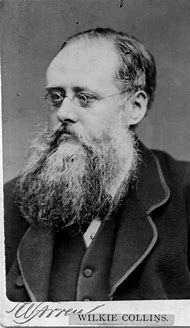Review: The Moonstone
T S Eliot said, “The first, the longest, and the best of modern English detective novels.” That is a fulsome recommendation of The Moonstone. Edgar Allen Poe wrote several mysteries as short stories in the early 1840’s, but in 1868, Wilkie Collins pioneered the following features of The Moonstone:
an English country house robberyan “inside job”red herringsa celebrated, skilled, professional investigatora bungling local constabularydetective enquiriesa large number of false suspectsthe “least likely suspect”a reconstruction of the crimea final twist in the plotwhich became became classic attributes of the twentieth-century detective story in novel form. At 436 pages The Moonstone is quite long.

William Wilkie Collins (8 January 1824 – 23 September 1889) was an English writer and the son of an English painter. He published his first story in 1843. He wrote his first novel, Tahiti as It Was, in 1844, but it was rejected in 1845 and remained unpublished during his lifetime. He was introduced to Charles Dickens in 1851 and they became fast friends. In 1852 his novel, Basil, was published. In 1853 while writing Hide and Seek, he suffered his first bout of gout, from which he was to suffer for the rest of his life. The novels Collins published in the 1860s are the best and most enduring of his career. The Woman in White, No Name, Armadale and The Moonstone were written in less than a decade. They sold in large numbers and made him a wealthy man. The inconsistent quality of Collins’s dramatic and fictional works in the last decade of his life was accompanied by a general decline in his health, including diminished eyesight. He was often unable to leave home and had difficulty writing. During these last years, he focused on mentoring younger writers. In 1858, Collins had begun living with Caroline Graves and her daughter Harriet. Collins disliked the institution of marriage, but remained dedicated to Caroline and Harriet, considering them to be his family. In 1868, Collins met Martha Rudd in Norfolk, and the two began a liaison. She was 19 years old and from a large, poor family. A few years later, she moved to London to be closer to him. Their daughter Marian was born in 1869; their second daughter, Harriet Constance, in 1871; and their son, William Charles, in 1874. When he was with Martha, Collins assumed the name William Dawson, and she and their children used the last name of Dawson themselves. For the last 20 years of his life Collins divided his time between Caroline, who lived with him at his home in Gloucester Place, and Martha, who was nearby.
The Plot: Rachel Verinder, a young English woman, inherits a large Indian diamond on her eighteenth birthday. It is a legacy from her uncle, a corrupt British army officer who seized it in India. The diamond is of great religious significance and extremely valuable, and three Hindu jugglers/priests have dedicated their lives to recovering it. She wears the diamond at her birthday, but it has disappeared the next day. Superintendent Seegrave, an incompetent local policeman, investigates the Indians and Rosanna Spearman, a housemaid, without success. During the ensuing year there are hints that the diamond was removed from the house and may be in a London bank vault, having been pledged as surety to a moneylender. The Indian jugglers are still nearby, watching and waiting. Franklin Blake, a cousin and suitor of Rachel’s, and who attended her 18th party, returns from overseas and resolves to solve mystery left unsolved by Sergeant Cuff, the famous English detective. Franklin learns that he was given laudanum (an opiate) by Dr Candy, the family doctor, because of his anxiety about Rachel and the diamond. Rachel herself tells Franklin that she saw him take the diamond, but she has not revealed the theft because of the consequences for him. Franklin tracks down the holder of the diamond when he redeems it from the bank at an appointed time. That man turns out to be Godfrey Ablewhite, who has embezzled a large sum and wanted the diamond to repay his debt. He, too, is a suitor of Rachel, and he had convinced Franklin, in his drugged stupor to give him the diamond to place it in safe keeping. After recovering the diamond from the bank, Godfrey is murdered by the Indians, who escape to India. Rachel and Franklin marry and a noted adventurer, Mr Murthwaite, explains that he has followed the Indians and seen the diamond returned to its proper place: in the forehead of a statue of an Indian god.
The story is quite a bit more complicated than that with a dozen more characters, and considerably more involvement. There are also multiple narrators of the story. The characters are all unique, with their defects and attractions, and their motives are clear, even if not well reasoned. It is difficult to put the book aside, in spite of its length. A modern editor would have abbreviated it by at least 100 pages by cutting the passages where the characters review in detail what has happened after each event. Still, it is an enchanting story of a Victorian crime in a Victorian setting.



